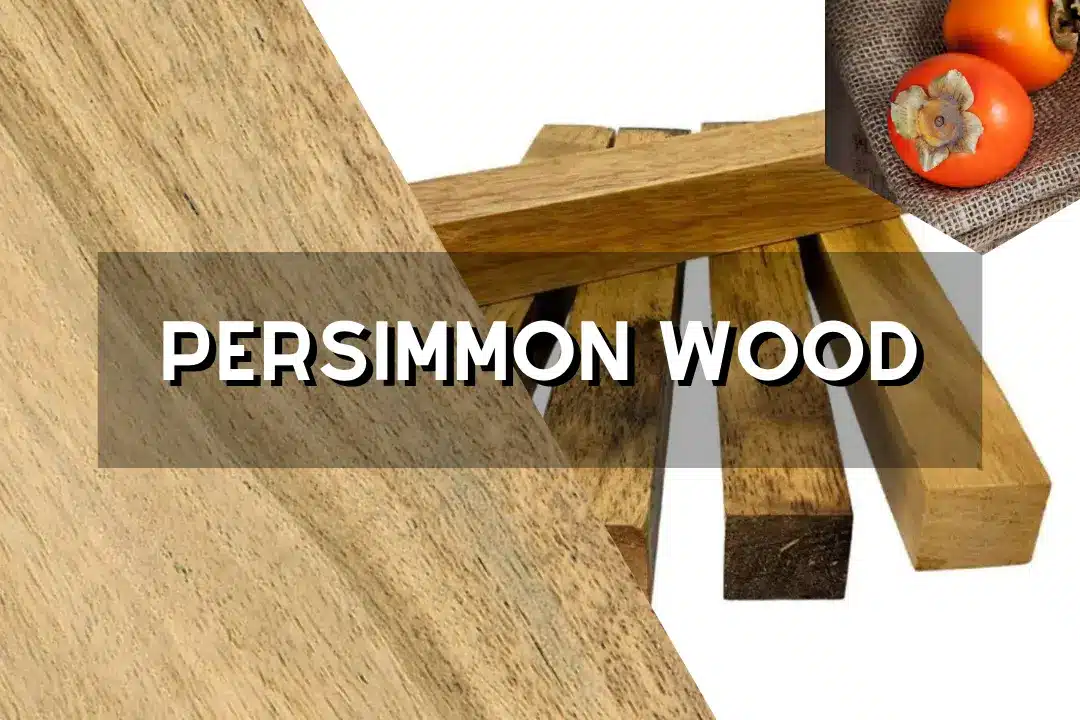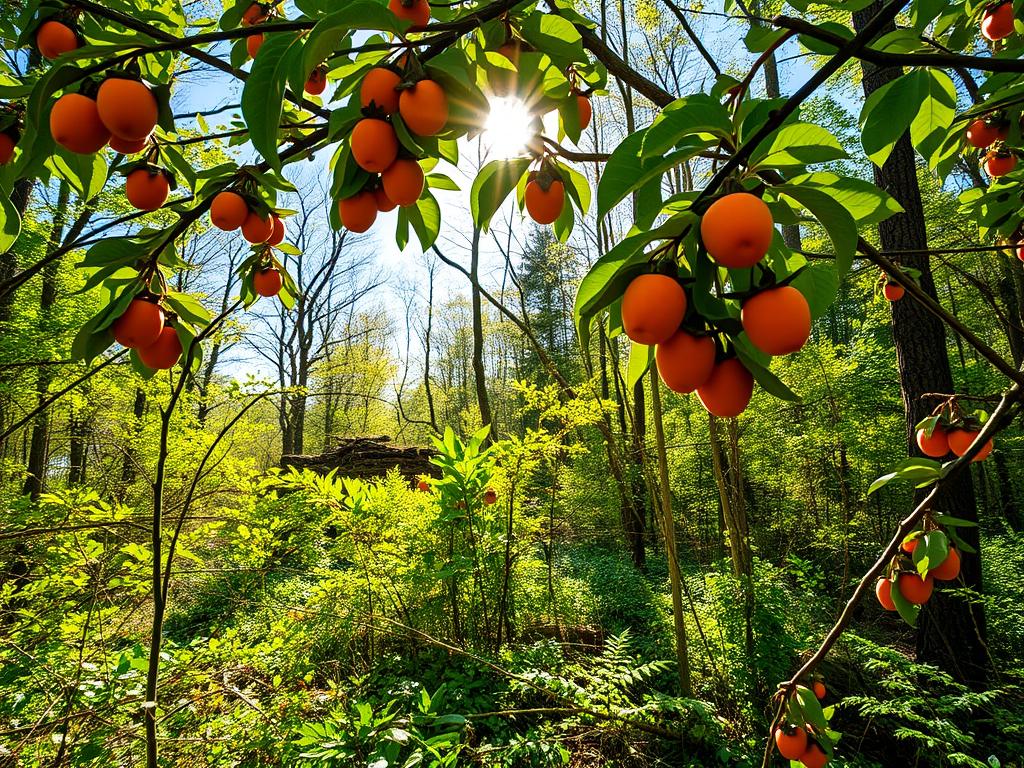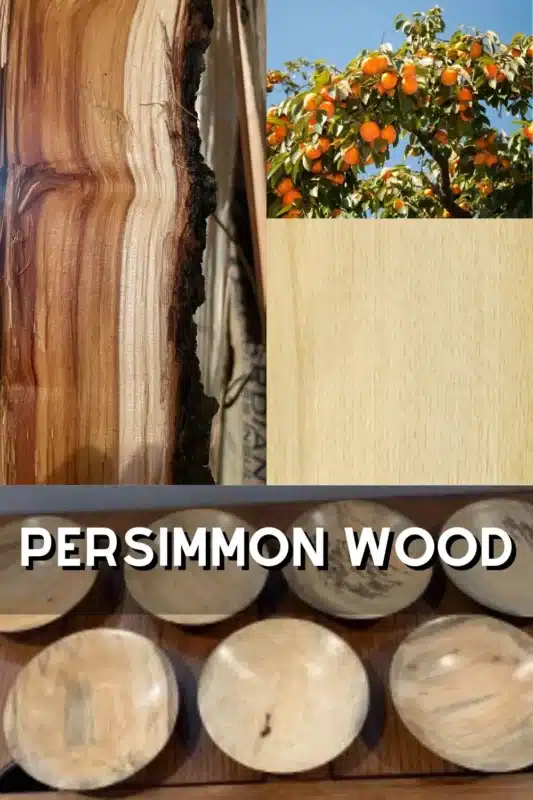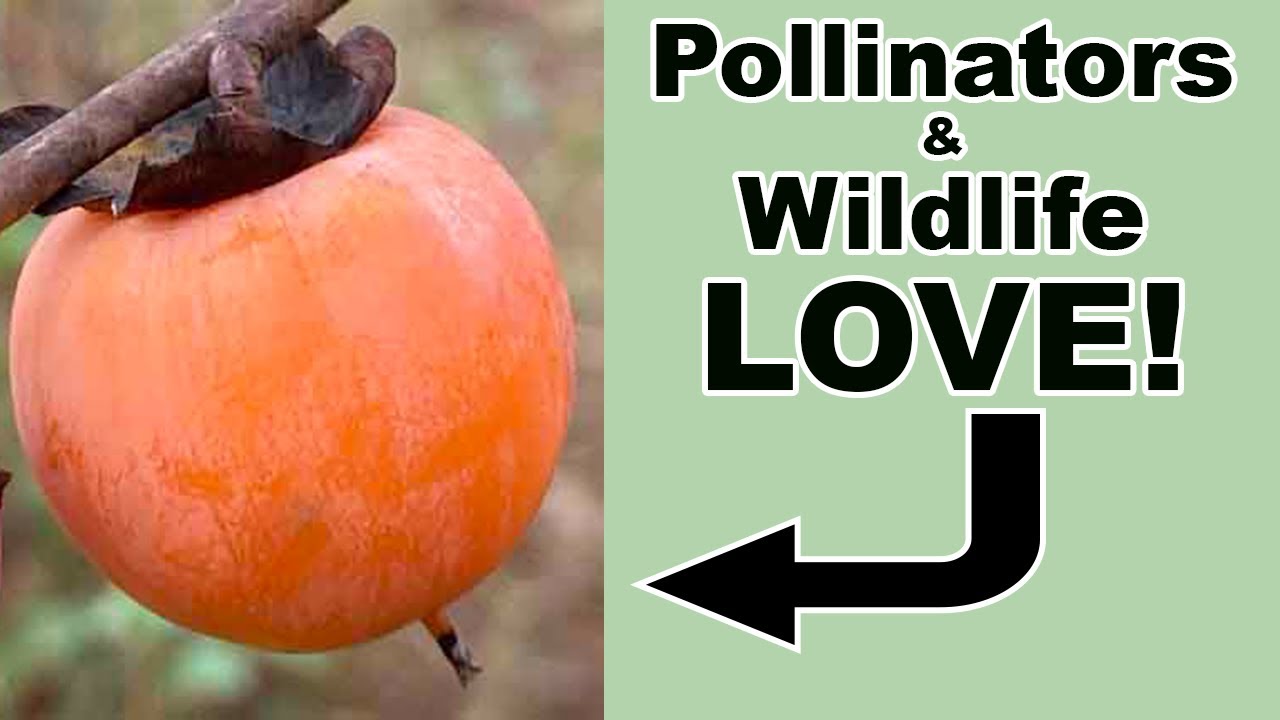
Persimmon Wood and Its Remarkable Natural Properties

Did you know persimmon wood comes from the American persimmon tree? It’s part of the same family as ebony. Despite being very dense and durable, it’s not as well-known as other hardwoods. This article will show you ten special qualities of persimmon wood. These qualities make it valuable for both craftsmanship and design.
It combines beauty with strength, making it stand out. Knowing these special qualities helps us see why this pale hardwood is a favorite among craftsmen and builders.
Table of Contents
What is Persimmon Wood?
Persimmon wood comes from the American persimmon tree, also known as Diospyros virginiana. It’s part of the ebony family, known for its unique look and feel. The wood’s color can range from pale white to dark brown or even black.
The color changes based on the tree’s age and where you cut it. This makes every piece of persimmon wood special and unique.
This is as hard as Caribbean rosewood and much harder than hickory, which is 1820.
This hardness makes this durable wood great for making musical instruments and fine woodwork. Even though it’s rare, woodworkers love it for its quality.
The wood has a lot of sapwood, which is lighter and more common than the heartwood. As the heartwood ages, it turns dark, almost black. This looks great against the lighter sapwood.
But, the sapwood is more vulnerable to insects, like powderpost beetles. This is because it has less tannin than the heartwood.
Origin and Distribution of Persimmon Wood
The common persimmon, known as Diospyros virginiana, grows in the eastern United States. It can be found from southern Connecticut to Florida. It also reaches as far west as Texas, Louisiana, Oklahoma, Kansas, and Iowa. These trees live in different places, like dry sandy woodlands, river bottoms, and rocky hillsides.
They can grow up to 115 feet tall. Their trunks are usually 1 to 2 feet wide. But, they may not grow straight or big because of their environment.
These trees do best in well-drained soils. They weigh about 52 lbs/ft³ and have a specific gravity of 0.7908. Their Janka hardness rating is 2,300 lbf, showing they are very durable.
In short, knowing where Diospyros virginiana comes from helps us understand its wood. This is key for the woodworking world, where getting this wood can be hard.

Unique Physical Properties of Persimmon Wood
Persimmon wood has special physical properties that make it appealing for many uses. Knowing about its density, color, and grain helps us appreciate this unique material.
Density and Weight Characteristics
This wood is very dense, weighing about 52 lbs/ft³. Its specific gravity ranges from .74 to .83, showing how it can change with moisture. This density makes the wood strong and durable, perfect for tough projects.
Color and Appearance
The color of persimmon wood is eye-catching. It has light sapwood and dark heartwood, creating a beautiful look. The color can vary from light yellow to deep brown, making it versatile for different designs.
Grain and Texture Analysis
Persimmon wood has a fine, smooth grain. It’s semi-ring-porous, which helps with clean cuts and polished finishes. Unlike some hardwoods, it doesn’t have wide pores, making it great for detailed designs.
Durability and Workability
Persimmon wood is known for its durability and workability. It’s a great choice for many uses. Knowing its Janka hardness, shrinkage, and work challenges is key for those interested in using it.
Janka Hardness Rating
Persimmon timber has a Janka hardness of 2,300 lbf. This makes it very resistant to wear and denting. It’s as hard as other dense hardwoods, making it perfect for places with lots of traffic and durable items.
Its hardness means persimmon wood lasts long and stays strong. It’s great for making furniture and musical instruments.
Shrinkage and Movement in Service
Persimmon wood usually has a moisture content of 10-18% after drying. It shrinks a lot, with radial shrinkage at 7.9% and tangential at 11.2%. This shrinkage can cause it to move a lot, depending on its stability and where it’s used.
Using coatings and protective measures helps reduce these effects. This makes the wood more stable.
Challenges in Workability
Working with this elegant hardwood can be tough because of its density and hardness. It’s okay with hand tools, but you need to pre-drill for nailing or screwing. The wood dulls tools a bit, but it can be shaped and finished well with the right methods.
This means craftsmen need to be careful and precise when working with this durable wood. It’s all about achieving quality and detail in their projects.

Rot Resistance and Insect Susceptibility
Persimmon wood has some key traits. It’s mainly seen as perishable. This means its sapwood doesn’t resist decay well, making it weak in wet places. To keep it lasting, treating the wood is a must.
Persimmon also faces many insect threats. These pests can harm the trees. They include:
- Clearwing Moth/Borer
- Queensland Fruit Fly
- Long-Tailed Mealybug
- Citrus Mealybug
These insects can eat away at the trees. They can cause leaves to shrink and growth to slow. So, keeping an eye on the trees and taking care of them is very important.
Diseases like Angular Leaf Spot and leaf spots can also hurt persimmon trees. They can cause leaves to fall off and make the trees weaker.
Common Uses of Persimmon Wood
Persimmon wood is known for its amazing qualities. It’s used in both craftsmanship and sporting equipment. Woodworkers and athletes love it for its durability and strength.
Applications in Craftsmanship
Artisans use the dense fruitwood to make kitchen tools, mallets, and detailed objects. Its hardness and fine grain help create lasting pieces. Some notable items include:
- Knife handles for beauty and function.
- Billiard cues that perform well.
- Drumsticks that improve sound quality.
It’s sought after by those who value both looks and durability.
Uses in Sporting Equipment
Persimmon wood has a long history in sports, mainly in golf clubs. Though demand has dropped, its durability is still valued. It’s used for:
- Golf club heads for shock resistance.
- Custom-made mallets for sports.
- Shoe lasts that need strong materials.
Its Janka hardness rating of 2300 makes it as strong as top woods. Making golf clubs involves over 200 steps, showing the wood’s craftsmanship.
Sustainability and Availability
This pale hardwood is sustainable, with the tree not listed as endangered. This means it’s safe from overharvesting. It’s good for the environment and supports fair trade. Persimmon trees are managed well, keeping their wood available for crafts and sports gear.
Even though persimmon wood is sustainable, it’s hard to find. The tree’s unique shape and small size limit how much wood can be cut. Trees grow up to 30 inches wide, making it hard to harvest a lot. Artisans pick the best wood by hand, which costs about $400.
In cities like Atlanta, people are finding new ways to use trees. This helps reduce waste and promotes green practices. Persimmon trees can grow fruit every two years. Local groups harvest wood sustainably, balancing nature with human needs.
| Characteristic | Details |
|---|---|
| Sustainability Rating | Not listed under CITES or IUCN |
| Average Cost of Slab | $400 |
| Maximum Wood Width | 30 inches |
| Minimum Wood Width | 11 inches |
| Average Wood Width | 13 inches |
| Average Wood Width | 13 inches |
| Annual Sustainable Harvest at PERI | 9-15 kg (approximately 20-30 lbs) |
| Total Estimated Annual Fruit Production | Approximately 143,000 fruits (1,990 kg) |
| At-Risk Score for Persimmon Harvest | 19 (on a scale of 0 to 96) |
Comparative Analysis with Other Woods
Looking at persimmon wood next to other types, like true ebony, shows its special qualities. This comparison helps us see why woodworkers choose certain woods. It’s all about the characteristics that matter most.
Persimmon Wood vs True Ebony
Persimmon wood looks and feels a lot like true ebony. But, it’s lighter than true ebony. This makes persimmon a good choice for those who want a similar look without the high cost.
Characteristics Compared to Other Hardwoods
Comparing Persimmon timber to other hardwoods shows its unique traits. Here’s a table that highlights these differences:
| Hardwood Type | Density (lb/ft³) | Janka Hardness Rating | Color | Workability |
|---|---|---|---|---|
| Persimmon | 42 | 1,200 | Dark brown with black streaks | Moderate |
| True Ebony | 75 | 3,080 | Jet black | Difficult |
| Maple | 43 | 1,450 | Light cream to reddish-brown | Easy |
| Walnut | 38 | 1,010 | Rich brown | Moderate |
| Oak | 44 | 1,290 | Light to dark brown | Easy |
This table shows how different hardwoods compare. Each wood has its own benefits for different projects. Persimmon wood stands out for its balance of qualities. It’s a versatile choice that can enhance both looks and function of a project.
Conclusion
Persimmon wood is special because of its unique mix of density and beauty. It’s used in making things and sports gear because of its physical and historical value. The design of persimmon clubs shows how it improves feedback and control in golf.
Even though it’s hard to find, people still want persimmon wood. It’s important for artists and builders. Knowing its traits helps us use it well in different areas. Plus, it’s good for the environment, helping local ecosystems.
Understanding persimmon wood’s many benefits shows its importance in making things and in nature. This premium fruitwood is a remarkable material with a promising future.
FAQs
What are the unique properties of persimmon wood?
Persimmon wood is known for its density, durability, and beauty. It has a high Janka hardness rating. This makes it versatile for many crafts.
Where does persimmon wood come from?
Persimmon wood comes from the American persimmon tree, known as Diospyros virginiana. It grows in the eastern United States. It thrives in well-drained soils and different environments.
How does persimmon wood compare to true ebony?
The wood of the persimmon tree is similar to true ebony in color and density. But it’s lighter and less dense. True ebony is more sought after and costs more.
Is persimmon wood durable?
Yes, persimmon wood is very durable. It has a Janka hardness rating of 2,300 lbf. It’s resistant to wear and denting. But, it needs proper treatment because it’s not resistant to decay or insects.
What are some common applications for persimmon wood?
Persimmon wood is used in fine crafting, like turned objects and knife handles. It’s also used in sports equipment because of its strength and beauty.
Is persimmon wood considered sustainable?
This pale hardwood is sustainable. It’s not listed under CITES Appendices or IUCN Red List. But, it’s rare because the tree is small. This makes it expensive in specialty markets.
What colors can persimmon wood have?
Persimmon wood can be white, dark brown, or black. The color depends on the tree part and age. These colors make it popular in woodworking and design.
What challenges are associated with working with persimmon wood?
Working with persimmon wood can be challenging. It’s hard to work with because of shrinkage and movement. Using the right techniques and tools is key to success.



